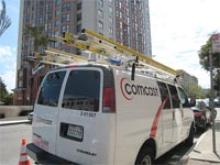My friend, Geoff Daily at
App-Rising.com, has
questioned the wisdom of running fiber to all anchor institutions.
There's been a lot of buzz around the benefits and relative viability of wiring all community anchor institutions (schools, libraries, hospitals, etc.) with fiber as the way to get the best bang for the broadband buck. But recent conversations with my fiber-deploying friends have led me to worry that doing this could be a big mistake.
...
The reason is simple: if you build a network to serve community anchors, then those institutions won't be available to serve as anchor customers for a community-wide deployment. Without those community anchors as customers, the economics of deployment, especially in rural areas, becomes much harder and may actually make robust, sustainable broadband impossible in some areas.
This is a question I have wrestled with also, in trying to help communities understand the real impacts of decisions they make on whether to build their own broadband network.
My first reaction is on philosophical grounds - public institutions like schools, police departments, etc., do not exist to prop-up the business models of cable or telephone companies. Large entities like municipal and county governments should own their own network because it will save them money and expand their capabilities. When will the tea-party protesters start protesting government paying exorbitant fees to telephone companies for slow T-1 lines and the like? After all, these are our tax dollars and they should be spent wisely.
My second reaction is that I seriously doubt removing these institutional networks will impact the business model significantly. Maybe it would have last decade, but now we know that Comcast and probably many more have
">massive margins in their broadband operations. Losing the libraries and schools will do little to their bottom lines. Even if it takes a bit out of their profits,
they won't go missing meals.
But really, the answer is more complicated.



